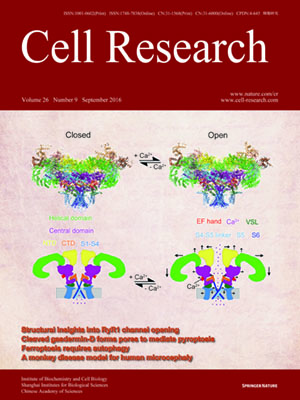
Volume 26, No 9, Sep 2016
ISSN: 1001-0602
EISSN: 1748-7838 2018
impact factor 17.848*
(Clarivate Analytics, 2019)
Volume 26 Issue 9, September 2016: 1048-1061
ORIGINAL ARTICLES
TALEN-based generation of a cynomolgus monkey disease model for human microcephaly
Qiong Ke1,2,3,4,*, Weiqiang Li1,2,4,5,*, Xingqiang Lai2,*, Hong Chen2, Lihua Huang1, Zhuang Kang6, Kai Li7, Jie Ren7, Xiaofeng Lin8, Haiqing Zheng9, Weijun Huang2, Yunhan Ma10, Dongdong Xu10, Zheng Chen11, Xinming Song11, Xinyi Lin11, Min Zhuang12, Tao Wang2,5, Fengfeng Zhuang13, Jianzhong Xi14, Frank Fuxiang Mao15, Huimin Xia1, Bruce T Lahn16, Qi Zhou17, Shihua Yang10 and Andy Peng Xiang1,2,4,5
1Program of Stem Cells and Regenerative Medicine, Affiliated Guangzhou Women and Children's Hospital, Zhongshan School of Medicine, Sun Yat-Sen University, Guangzhou 510623, China
2Center for Stem Cell Biology and Tissue Engineering, Key Laboratory for Stem Cells and Tissue Engineering, Ministry of Education, Sun Yat-Sen University, Guangzhou 510080, China
3Department of Biology, Zhongshan Medical School, Sun Yat-Sen University, Guangzhou 510080, China
4Guangdong Key Laboratory of Reproductive Medicine, Guangzhou 510080, China
5Department of Biochemistry, Zhongshan Medical School, Sun Yat-Sen University, Guangzhou 510080, China
6Department of Radiology, the Third Affiliated Hospital of Sun Yat-Sen University, Guangzhou 510632, China
7Department of Ultrasound, the Third Affiliated Hospital of Sun Yat-sen University, Guangzhou 510632, China
8Department of Radiology, Sun Yat-Sen Memorial Hospital, Sun Yat-Sen University, Guangzhou 510120, China
9Department of Rehabilitation Medicine Science, the Third Affiliated Hospital of Sun Yat-sen University, Guangzhou 510632, China
10College of Veterinary Medicine, Guangdong Provincial Key Laboratory of Prevention and Control for Severe Clinical Animal Diseases, South China Agricultural University, Guangzhou 510642, China
11Department of Medical Genetics, Zhongshan School of Medicine, Sun Yat-sen University, Guangzhou 510080, China
12School of Life Science and Technology, ShanghaiTech University, Shanghai 200031, China
13Beijing ViewSolid Biotechnology, Beijing 100034, China
14Department of Biomedical Engineering, College of Engineering, Peking University, Yannan Yuan 60, Beijing 100871, China
15State Key Laboratory of Ophthalmology, Zhong Shan Ophthalmic Center, Sun Yat-sen University, Guangzhou 510060, China
16Department of Human Genetics, University of Chicago, Chicago, IL 60637, USA
17State Key Laboratory of Stem cell and Reproductive Biology, Institute of Zoology, Chinese Academy of Sciences, Beijing 100101, China
Correspondence: Andy Peng Xiang, E-mail: xiangp@mail.sysu.edu.cn; Shihua Yang, E-mail: yangsh@scau.edu.cn; Qi Zhou,(qzhou@ioz.ac.cn)
Gene editing in non-human primates may lead to valuable models for exploring the etiologies and therapeutic strategies of genetically based neurological disorders in humans. However, a monkey model of neurological disorders that closely mimics pathological and behavioral deficits in humans has not yet been successfully generated. Microcephalin 1 (MCPH1) is implicated in the evolution of the human brain, and MCPH1 mutation causes microcephaly accompanied by mental retardation. Here we generated a cynomolgus monkey (Macaca fascicularis) carrying biallelic MCPH1 mutations using transcription activator-like effector nucleases. The monkey recapitulated most of the important clinical features observed in patients, including marked reductions in head circumference, premature chromosome condensation (PCC), hypoplasia of the corpus callosum and upper limb spasticity. Moreover, overexpression of MCPH1 in mutated dermal fibroblasts rescued the PCC syndrome. This monkey model may help us elucidate the role of MCPH1 in the pathogenesis of human microcephaly and better understand the function of this protein in the evolution of primate brain size.
10.1038/cr.2016.93
FULL TEXT | PDF
Browse 2033


